Pop quiz: Don’t keep your __________________ waiting!
You probably guessed “customers” or “clients” right? This is because you thought from a business perspective and you are absolutely correct!
When it comes to getting questions answered or problems solved, there is one thing that almost all customers have in common – they do not like to wait.
According to research carried out by HubSpot, 90% of customers rate “immediate” response as a must when they have a customer service question. Furthermore, 60% of customers define “immediate” as 10 minutes or less.
Today, more and more businesses are turning toward Artificial Intelligence (AI) driven chatbots, in order to provide their customers with more convenience and better experience – this includes minimizing the customer waiting period and establishing a personalized communication channel.
So what’s the big deal about an AI-based chatbot? What exactly it is? How it works? Why care about it?
Grab some popcorn and continue reading this guide as it discusses all you need to know about AI-enabled chatbots.
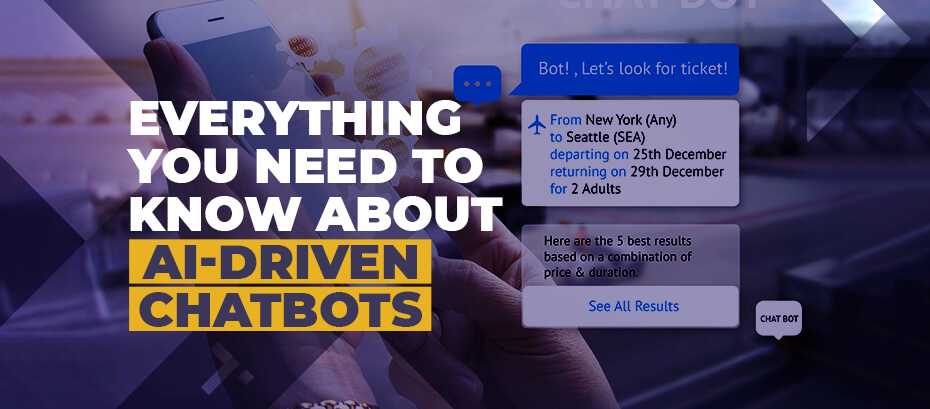
Table of Contents:
Shield your business identity with the power of AI chatbots.
Talk with one of our AI experts!
Debunking the Myth
What is a chatbot? It is an Artificial Intelligence Solution that simulates interactive human conversation…
Woah, woah, woah… Wait a second!
Before we get into AI-powered chatbots, it is important for us to understand that not every chatbot utilizes the true power of AI (i.e. chatbot with AI).
Basically, there are two types of chatbots: Scripted Chatbots and AI Chatbots.
The scripted ones are the earliest iteration of an intelligence mechanism and have been around for years. But they can’t be called as genuine AI chatbots. In fact, they are programmed to respond in pre-defined ways.

Evolution of Conversational AI (Source: Deloitte)
On the other hand, the AI ones are developed using Natural Language Processing (NLP) and Machine Learning (ML). These chatbots are able to learn and respond with efficient processing speed.
We can say that with genuine AI chatbots, the possibilities are endless.
With that said, let’s dive into the world of AI chatbots.
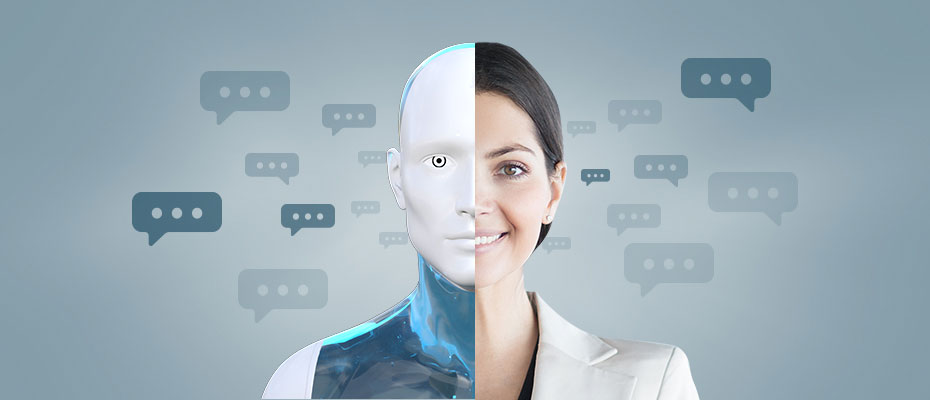
What is an AI-based chatbot?
Technically speaking, an AI chatbot is an automated program that taps into AI capabilities in order to interact with humans via text input, audio input, or both. In simple words, it is an application that can think like humans and carry out conversations. It is independent of human intervention.
When it is said that “AI chatbots can think like humans”, it basically means that AI chatbots can work on the basis of the knowledge database available to them at that point in time.
If any conversation introduces a concept that they are not programmed to understand, they will either avoid that conversation or potentially pass it to a human operator. The infusion of AI plays a vital role over here; it enables the chatbots to learn from such conversations and prepare for the future.
Examples:
When it comes to the examples of AI-driven chatbots (which include virtual assistants), you are already using some of them in your day to day life: Apple’s Siri, Google Assistant, Microsoft’s Cortana, Amazon Echo, and Facebook Messenger.
Here are some more examples that will help you better understand the blend of AI and bots:
- Weather bot: Get information on live weather conditions
- Food ordering bot: Ask for the menu & order food online
- News bot: Ask for the latest news that interest you
- Finance bot: Manage money in a better way
- Personal assistant: Get answers to all your general queries
Transform customer service with an intelligent chatbot.
We’re there to get you started!
How does an AI chatbot work?
At the heart of an AI-enabled chatbot sits its architecture. It is the mechanism that determines how a chatbot is going to work. Mostly, it is developed on the basis of the client’s requirements and the usability & context of business operations.
Its architecture mainly depends on these three components:
- Natural Language Understanding (NLU)
- Dialogue Manager
- Natural Language Generation (NLG)
The following diagram shows the basic architecture of an AI chatbot:
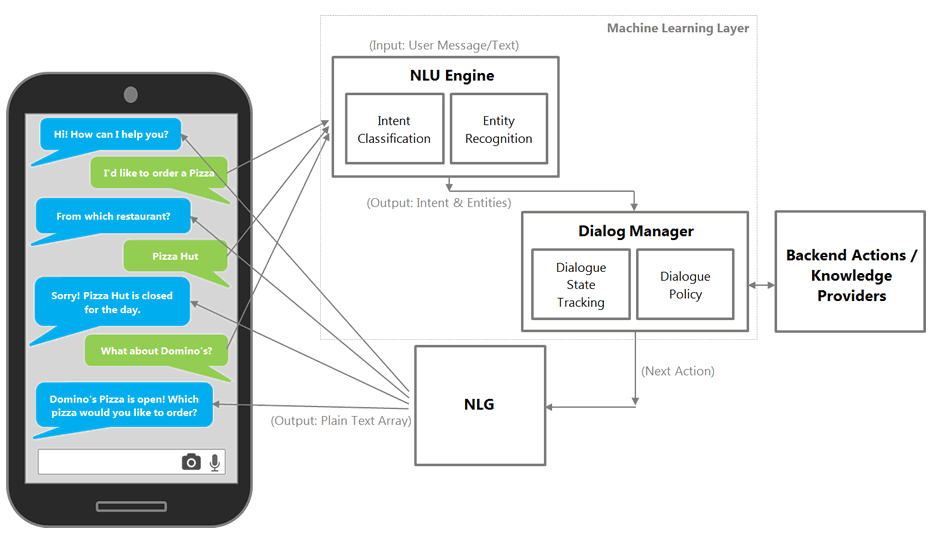
NLU Engine
NLU (a subset of NLP) is all about understanding the user input or request, classifying the intent, and recognizing or extracting the entities.
Here, an important thing for us to understand is that the input provided to the NLU engine is in the form of text; in case of audio inputs, automatic speech recognition (ASR) is used to convert speech into text, before feeding it to the NLU engine.
It mainly consists of:
- Intent: It represents an activity that a user wants to perform. For instance, in the above chatbot example, the intent is to ‘order’ pizza.
- Entity: It represents an idea or a concept. For instance, in the above chatbot example, the entity is ‘pizza’ (i.e. food).
Dialogue Manager (DM)
As the name suggests, it handles the actual context of the user’s dialogue.
For instance, the user types “I want to order garlic bread” and the chatbot takes the order. In a while, the user changes the order and types “Change it to cheese roll.” In this case, the user is clearly referring to the order which was placed earlier. So, the chatbot should correctly comprehend this and make changes to the order. DM helps the chatbot to accomplish this.
It has the following sub-components:
- Dialogue State Tracking (DST): It maintains the state of the previous conversation. Utilizing the input intent, DST determines if the new entity value received should change existing entity values. In the above example, garlic bread à cheese roll. If the NLU engine’s intent is to add to the existing entities with new data, DST does that.
- Dialogue Policy (DP): As soon as the DST updates the state of the current conversation, the DM consults with the DP for the next best step to be taken to help the user accomplish the task. It can be to ask a relevant follow-up question or provide a suggestion or let the user confirm the order as the task has been accomplished. Technically speaking, DP is a high-level framework that trains the chatbot to take the next smart-step (i.e. knowledge management) during the conversation in order to improve the satisfaction of the end-user.
NLG
NLG marks the end of the chatbot’s architecture. This is the component where the user reply is constructed on the basis of the output from the DM.
NLG converts structured data into text. In a way, it does the reverse of what NLU does.
NLG contains several user-defined templates that map to the action names. So, based on the action determined by the DM, the corresponding template message is invoked. If the template requires some placeholder values to be filled up, those values are also passed by the DM to the NLG.
Finally, an appropriate text or message is displayed to the user and the chatbot goes into a wait mode (i.e. it waits for the user’s input).
Why you should care to build your own AI chatbot?
The race to provide exceptional user experiences is on! Organizations are realizing the value of delivering an experience that makes them stand out from their competition.
One of the smart ways to elevate the level of user experience is to insert new elements into the existing business model – like implementing an AI-based chatbot.
According to a study by Salesforce, 53% of service organizations expect to use AI chatbots within 18 months — a 136% growth rate that foreshadows a big role for the technology in the near future.
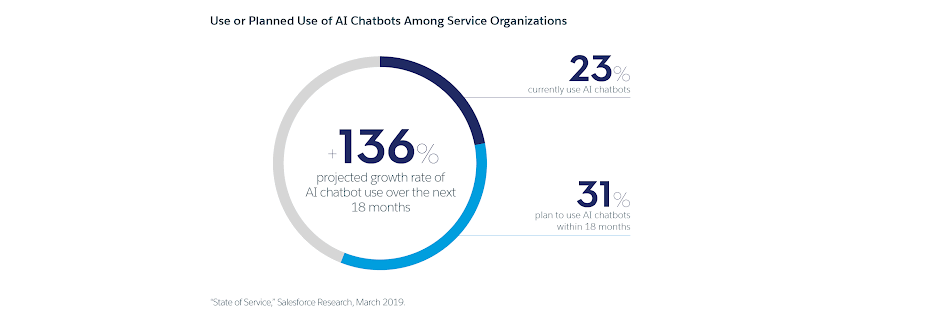
Use or Planned Use of AI Chatbots among Service Organizations (Source: Salesforce)
By filtering the service organizations based on their industries, here’s another chart full of interesting statistics:
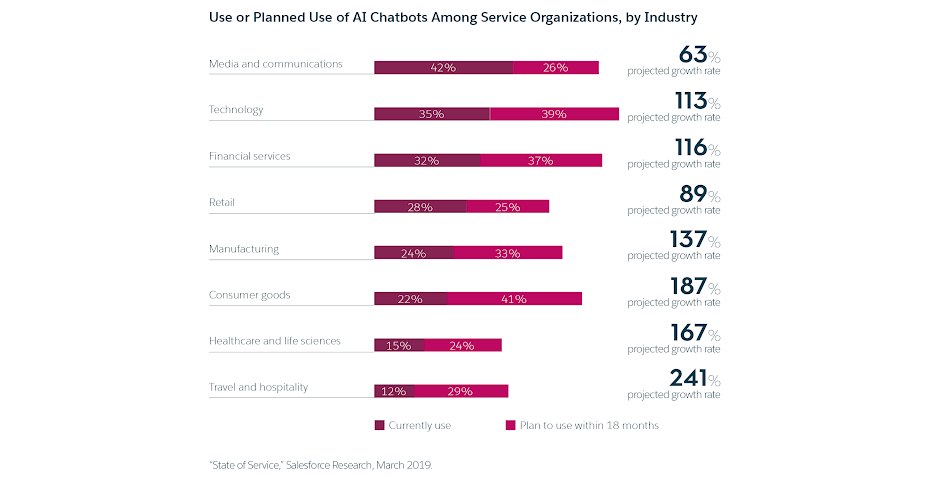
Use of AI Chatbots among Service Organizations, by Industry (Source: Salesforce)
Now, let’s go through the reasons that explain the importance of having your own AI-powered chatbot:
- Minimize the customer waiting period: With a chatbot, you can provide an effective platform to your customers to avoid long wait times for call-based customer support agents or even for email & form-based support.
- Establish a personalized communication channel: As chatbots can remember the preferences of your customers, you get to develop a personalized communication channel with your customers; this helps in improving the satisfaction and loyalty of your customers.
- Provide 24/7 support: Chatbot gives you the opportunity to remain available round the clock; with this, your customers can connect with you at any point in time.
- Fetch more leads: Chatbot can help you initiate conversations that your sales executives can follow-up on.
- Reduce costs: By deploying a chatbot you can reduce the number of employees who are required to speak with your customers; furthermore, you can avoid scaling-up your staff.
While AI chatbots can’t replace humans, they can add lots of value to your customer support experience, giving your customers a friendly tool to get what they need.
If you haven’t already started experimenting with chatbots then now is the best time.
As a leading chatbot app development company, Helios Solutions offers smart, well-trained chatbots tailored to suffice your domain-specific needs. Our solutions not only enable you to redefine customer support and services but also to accommodate your customers’ expectations of personalized experience across the channel.
RaCom
RaCom is an AI-driven chatbot for e-commerce businesses. It enables customers to discover products, purchase online, track orders, manage complaints & queries, and much more.
Businesses that are looking to provide their customers with a personalized online shopping experience, RaCom can be their companion.
Learn more about RaCom here.
Redefine customer support with an AI-based chatbot.
Contact us today!



